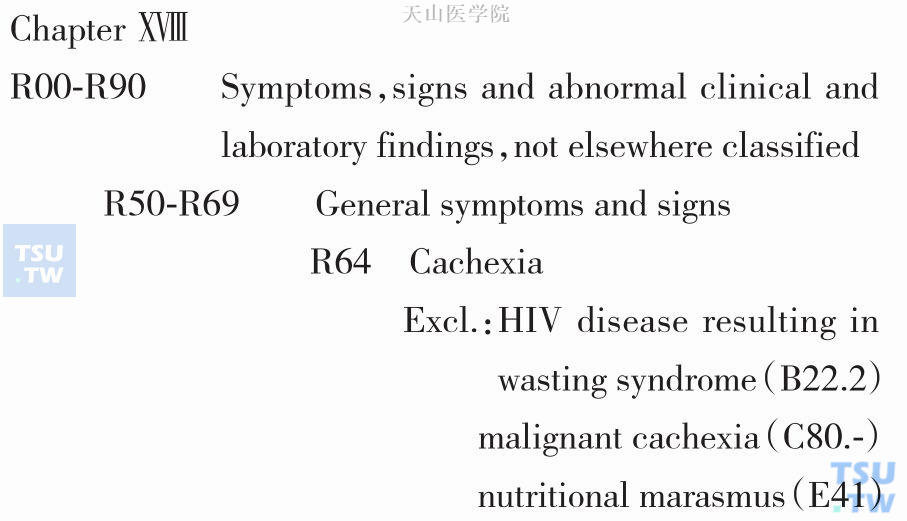恶液质(cachexia)也称为恶病质。2006年,Cachexia Consensus Conference将其定义为“一个复杂的代谢综合征与潜在的疾病,表现为肌肉损失和(或)脂肪的损失”(acomplex metabolic syndrome associated with underlying illness and characterized by loss of muscle with or without loss of fat mass)。可见于多种疾病,包括肿瘤、AIDS、严重创伤、手术后、吸收不良及严重的败血症等,其中以肿瘤伴发的恶液质最为常见,称为肿瘤恶液质。肿瘤恶液质是一种以体重下降、食欲缺乏、代谢改变、精神疲倦、机体性能降低为特点的综合征,主要表现为进行性消耗。是超过80%癌症晚期患者死亡之前的必经阶段,特别是胃肠、胰腺、胸和头颈部恶性肿瘤。目前没有根本治疗手段。其中20%癌症患者死亡直接与恶液质有关。恶液质的发生多指机体处于严重的功能失调状态,患者往往表现为显著消瘦、贫血、精神衰颓等全身功能衰竭的现象,严重影响患者的治疗效果和生活质量。
Cachexia是一个后拉丁语名词,来源于希腊语名词kachexia,意义为“坏状态”(bad condition),是一个合成词,由两个词根κακός(kakos)“bad坏”和 ξις(hexis)“condition状态”组成,拉丁语“echein”相当于英文的“have”,中文的“有”。Cachexia的同韵语有alexia、dyslexia、pyrexia。Cachexia的变异形式为cachexy,所以它的复数形式有ca•chex•ias及ca•chex•ies两种。
ξις(hexis)“condition状态”组成,拉丁语“echein”相当于英文的“have”,中文的“有”。Cachexia的同韵语有alexia、dyslexia、pyrexia。Cachexia的变异形式为cachexy,所以它的复数形式有ca•chex•ias及ca•chex•ies两种。
从希波克拉底时代算起,我们认识到恶液质的存在已经有2400年历史,但是,对于“什么是恶液质?”这样一个简单的问题我们仍然显得力不从心。而且随着我们对恶液质认识的加深,恶液质的定义一直在变化之中。尽管我们曾经给予恶液质很多不同的定义,但是这些定义对于恶液质的本质来讲仍然是盲人摸象。不同的人从不同的角度定义恶液质,在所有这些定义中,以欧洲肠外肠内营养学会(European Society of Parenteral and Enteral Nutrition,ESPEN)教育与临床实践委员会主席、英国营养杂志主编Alessandro Laviano教授的定义让人印象最为深刻,他认为恶液质是一种“你唯一能吃的就是你自己”的状态(Cancer anorexia-cachexia syndrome—when all you can eat is yourself)。
中国于2002年接受并开始使用疾病和有关健康问题的国际统计分类(International Statistical Classification of Diseases and Related Health Problems,ICD,也作International Classification of Diseases,国际疾病分类),Cachexia在ICD第10版(ICD 10thRevision,ICD-10)中的排列情况如下:

从上面的疾病国际分类,我们不难看出,恶液质归类于一种症状、体征、实验室及临床异常,是一种临床综合征或一种临床症候群,而不是一个独立的疾病。不同的词典对它的解释有一些的差异。
2003年版《柯林斯英语词典》(Collins EnglishDictionary)对cachexia 的定义为“(Pathology) a generally weakened condition of body or mind resulting from any debilitating chronic disease.”即任何慢性消耗性疾病造成的身体或心理虚弱状态。
2005年版《美国传统科学词典》(The AmericanHeritage® Science Dictionary)对cachexia的定义为“Severe weight loss,anorexia,and general debility that occur as a result of chronic disease. Cachetic patients exhibit signs of malnutrition,including muscle wasting.”即慢性疾病导致的严重体重丢失、厌食及整体衰弱,恶液质患者表现出营养不良,包括肌肉消耗。
2008年版《盖尔医学百科全书》(The GaleEncyclopedia of Medicine)对cachexia的定义为“General physical or mental poor health;weakness or malnutrition.”即生理及心理的恶劣状态,虚弱及营养不良。
2009年第4版《美国传统英语词典》(TheAmerican Heritage® Dictionary of the English Language)对cachexia的定义为“Weight loss,wasting of muscle,loss of appetite,and general debility that can occur during a chronic disease.”即慢性疾病过程可能发生的体重丢失、肌肉消耗、食欲下降以及身体虚弱。
2010年版《兰登Kernerman韦氏大学词典》(Random House Kernerman Webster's College Dictionary)对cachexia的定义为“General ill health with emaciation,usu. occurring in association with a disease.”即与疾病相关的整体衰弱病态。
2012年版Wordnet 3.0 Farlex Clipart Collection 对cachexia的定义为“Any general reduction in vitality and strength of body and mind resulting from a debilitating chronic disease.”即慢性消耗性疾病造成的任何体力及智力的全面减弱。
最新韦氏在线词典(Merriam-Webster online dictionary)对cachexia的定义是“General physical wasting and malnutrition usually associated with chronic disease.”即与慢性疾病相关的全身消耗和营养不良。
最新维基百科(Wikipedia)对cachexia的定义为“cachexia or wasting syndrome is loss of weight,muscle atrophy,fatigue,weakness,and significant loss of appetite in someone who is not actively trying to lose weight. The formal definition of cachexia is the loss of body mass that cannot be reversed nutritionally:Even if the affected patient eats more calories,lean body mass will be lost,indicating a primary pathology is in place.”即恶液质或消耗综合征是非主动减重者的体重丢失、肌肉萎缩、乏力、虚弱及严重食欲下降。Cachexia的正式定义为营养不能纠正的组织块减少,即使患者摄入更多能量,瘦体组织仍然下降,提示原发病在发挥作用。
2011年Fearon K等专家发布了国际恶液质专家共识,将肿瘤恶液质(cachexia)定义为“A multifactorial syndrome defined by an ongoing loss of skeletal muscle mass (with or without loss of fat mass) that cannot be fully reversed by conventional nutritional support and leads to progressive functional impairment.”以骨骼肌块(skeletal muscle mass)持续(ongoing)下降为特征的多因素综合征,伴随或不伴随脂肪块(fat mass)减少,不能被常规的营养治疗逆转,最终导致进行性(progressive)功能障碍。其病理生理特征是摄食减少、代谢异常等因素综合作用引起的蛋白质及能量负平衡。
